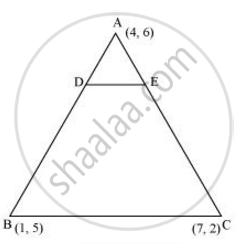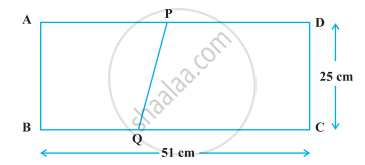Advertisements
Advertisements
प्रश्न
The vertices of a ΔABC are A (4, 6), B (1, 5) and C (7, 2). A line is drawn to intersect sides AB and AC at D and E respectively, such that `(AD)/(AB) = (AE)/(AC) = 1/4`Calculate the area of the ΔADE and compare it with the area of ΔABC. (Recall Converse of basic proportionality theorem and Theorem 6.6 related to ratio of areas of two similar triangles)
उत्तर

Given that (AD)/(AB) = (AE)/(AC) = 1/4
(AD)/(AD+DB) = (AE)/(AE+EC) = 1/4
(AD)/(DB)=(AE)/(EC) = 1/3
Therefore, D and E are two points on side AB and AC respectively such that they divide side AB and AC in a ratio of 1:3
Coordinates of Point D =`((1xx1+3xx4)/(1+3),(1xx5+3xx6)/(1+3))`
`= (13/4, 23/4)`
Coordinates of Point E =`((1xx7+3xx4)/(1+3), (1xx2+3xx6)/(1+3))`
`= (19/4, 20/4)`
Area of triangle =`1/2[x_1(y_2-y_3)+x_2(y_3-y_1)+x_3(y_1-y_2)]`
Area of ΔADE =`1/2[4(23/4-20/4)+13/4(20/4-6)+19/4(6-23/4)]`
`=1/2[3-13/4+19/16] = 1/2[(48-52+19)/16] = 15/32 `
Area of ΔABC =`1/2[4(5-2)+1(2-6)+7(6-5)]`
`= 1/2[12-4+7] = 15/2 `
Clearly, the ratio between the areas of ΔADE and ΔABC is 1:16.
Alternatively,
We know that if a line segment in a triangle divides its two sides in the same ratio, then the line segment is parallel to the third side of the triangle. These two triangles so formed (here ΔADE and ΔABC) will be similar to each other.
Hence, the ratio between the areas of these two triangles will be the square of the ratio between the sides of these two triangles.
Therefore, ratio between the areas of ΔADE and ΔABC =` (1/4)^2 = 1/16`
APPEARS IN
संबंधित प्रश्न
The vertices of ∆ABC = are A (4, 6), B(1, 5) and C(7, 2). A line is drawn to intersect sides AB and AC at D and E respectively such that `\frac{AD}{AB}=\frac{AE}{AC}=\frac{1}{4}` .Calculate the area of ∆ADE and compare it with the area of ∆ABC
The coordinates of A, B, C are (6, 3), (–3, 5) and (4, – 2) respectively and P is any point (x, y). Show that the ratio of the areas of triangle PBC and ABC is
In each of the following find the value of 'k', for which the points are collinear.
(8, 1), (k, -4), (2, -5)
The area of a triangle is 5. Two of its vertices are (2, 1) and (3, −2). The third vertex lies on y = x + 3. Find the third vertex.
Find the area of a triangle whose sides are respectively 150 cm, 120 cm and 200 cm ?
Find a relation between x and y, if the points A(x, y), B(-5, 7) and C(-4, 5) are collinear.
If the points P(-3, 9), Q(a, b) and R(4, -5) are collinear and a+b=1, find the value of a and b.
The points (0, 5), (0, –9) and (3, 6) are collinear.
The dimensions of a rectangle ABCD are 51 cm × 25 cm. A trapezium PQCD with its parallel sides QC and PD in the ratio 9 : 8, is cut off from the rectangle as shown in the following figure. If the area of the trapezium PQCD is `5/6` th part of the area of the rectangle, find the lengths QC and PD.

Find the missing value:
| Base | Height | Area of parallelogram |
| ______ | 8.4 cm | 48.72 cm2 |
